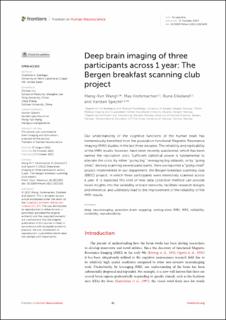| dc.contributor.author | Wang, Meng-yun | |
| dc.contributor.author | Korbmacher, Max | |
| dc.contributor.author | Eikeland, Rune Andreas | |
| dc.contributor.author | Specht, Karsten | |
| dc.date.accessioned | 2023-02-01T15:00:53Z | |
| dc.date.available | 2023-02-01T15:00:53Z | |
| dc.date.created | 2022-12-06T16:37:19Z | |
| dc.date.issued | 2022-10-17 | |
| dc.identifier.issn | 1662-5161 | |
| dc.identifier.uri | https://hdl.handle.net/11250/3047801 | |
| dc.description.abstract | Our understanding of the cognitive functions of the human brain has tremendously benefited from the population functional Magnetic Resonance Imaging (fMRI) studies in the last three decades. The reliability and replicability of the fMRI results, however, have been recently questioned, which has been named the replication crisis. Sufficient statistical power is fundamental to alleviate the crisis, by either “going big,” leveraging big datasets, or by “going small,” densely scanning several participants. Here we reported a “going small” project implemented in our department, the Bergen breakfast scanning club (BBSC) project, in which three participants were intensively scanned across a year. It is expected this kind of new data collection method can provide novel insights into the variability of brain networks, facilitate research designs and inference, and ultimately lead to the improvement of the reliability of the fMRI results. | en_US |
| dc.language.iso | eng | en_US |
| dc.publisher | Frontiers | en_US |
| dc.rights | Navngivelse 4.0 Internasjonal | * |
| dc.rights.uri | http://creativecommons.org/licenses/by/4.0/deed.no | * |
| dc.title | Deep brain imaging of three participants across 1 year: The Bergen breakfast scanning club project | en_US |
| dc.type | Journal article | en_US |
| dc.type | Peer reviewed | en_US |
| dc.description.version | publishedVersion | en_US |
| dc.rights.holder | Copyright 2022 the authors | en_US |
| dc.source.articlenumber | 1021503 | en_US |
| cristin.ispublished | true | |
| cristin.fulltext | original | |
| cristin.qualitycode | 1 | |
| dc.identifier.doi | 10.3389/fnhum.2022.1021503 | |
| dc.identifier.cristin | 2089632 | |
| dc.source.journal | Frontiers in Human Neuroscience | en_US |
| dc.identifier.citation | Frontiers in Human Neuroscience. 2022, 16, 1021503. | en_US |
| dc.source.volume | 16 | en_US |

